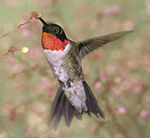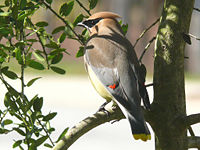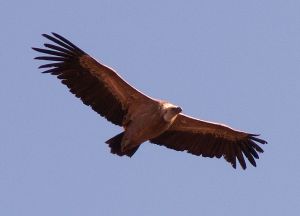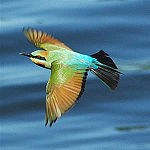Bird migration
Bird migration refers to the regular (and often seasonal) journeys to and from a given area undertaken by all or part of a bird population. Not all bird species (or even populations within the same species) are migratory. In contrast to more irregular movements such as emigration, nomadism, and invasion, which are made in response to changes in food availability, habitat, or weather, bird migration is marked by its cyclical pattern.
The most common pattern among the migratory birds of Europe and North America involves flying north to breed in the temperate or arctic summer and returning to wintering grounds in warmer regions to the south. However, other patterns of migration have been observed: In tropical regions, for example, some species migrate in response to the cycle of wet and dry seasons. In mountainous areas, like the Himalayas, vertical movements may occur from higher breeding grounds to lower altitudes with less exposure to harsh winter weather.
The primary advantage of migration is energetic. In the Northern Hemisphere, the long days of summer provide greater opportunities for breeding birds to feed their young. As the days shorten in autumn, the birds return to warmer regions where the available food supply varies little with the season. Migratory birds have evolved to undertake long-distance flights efficiently, and they undergo physiological changes (such as an accumulation of fat stores) prior to migration that minimize the energetic cost of flight.
Migrations typically occur along established routes called "flyways." The migrating species often return to the area of their birth to breed. The birds are guided by innate behaviors (including hormonal signals) that enable them to know when to depart and that orient them toward a specific location over long distances. However, they also remain flexible to environmental conditions, such as food supply and temperature, which may fluctuate yearly.
Bird migration has larger ecological implications that underscore the interconnectedness of life: Migratory cycles are closely attuned to seasonal food productivity cycles, which leads to a mutual gain for both the migrating species and the ecosystems in which they participate. Migratory birds are able to settle in areas where life is not tenable year-round, while the food resources of some regions would not be adequately utilized without the seasonal presence of migrating populations.
Bird species have diverse modes of migration
The varied patterns and modes of bird migration may be understood as adaptations. In fact, migration itself has conferred an advantage to only certain bird species, while not evolving in other species that remain resident, or sedentary, year-round. Whether a particular species migrates depends on a number of factors. The climate of the breeding area is important, as few species can cope with the harsh winters of inland Canada or northern Eurasia. The nature of the staple food is also significant. Most specialist insect eaters that breed outside the tropics are long-distance migrants, and have little choice but to head south in winter.
Even within a given species, not all populations may be migratory—a phenomenon termed "partial migration." Partial migration is very common in the southern continents; in Australia, 32 percent of passerine (perching) species and 44 percent of non-passerine birds were found to be partially migratory (Chan 2001). Moreover, within a specific population, there can be different patterns of timing and migration based on characteristics like age and sex. For example, only the female Chaffinches of Scandinavia migrate, while the males stay resident, a migratory pattern that has given rise to the name coelebs, meaning "bachelor."
Migrations vary widely in terms of the distance traveled. Short-distance passerine migrants, such as the waxwings, are effectively moving in response to winter weather, rather than enhanced breeding opportunities. Some Alaskan Bar-tailed Godwits have the longest non-stop flight of any migrant, flying 11,000 kilometers (km) to their New Zealand non-breeding areas. Prior to migration, 55 percent of their bodyweight is stored fat to fuel this uninterrupted journey. The Arctic Tern has the longest-distance migration of any bird, and sees more daylight than any other, moving from its Arctic breeding grounds to the Antarctic wintering areas. One Arctic Tern, ringed (banded) as a chick on the Farne Islands off the British east coast, reached Melbourne, Australia in just three months from fledging, a sea journey of over 22,000km (14,000 miles).
Migrations may be diurnal (occurring during the day) or nocturnal. Many of the smaller insectivorous birds, including the warblers, hummingbirds, and flycatchers, are nocturnal migrants. By migrating at night, they minimize the risk of predation, and avoid the overheating that could result from the energy expended to fly such long distances. Those smaller species that migrate during the day tend to be those making movements that are relatively short and weather-driven, like the larks and finches, or that can feed on the wing, like swallows and swifts.
The altitude at which birds fly during migration also varies. In general, migratory birds fly at low altitude, with most migrations in the range of 500-2000 feet. However, an expedition to Mt. Everest found skeletons of Pintail and Black-tailed Godwit at 16,400 feet on the Khumbu Glacier (Geroudet 1995). Bar-headed Geese have been seen flying over the highest peaks of the Himalayas above 29,000 feet even when low passes of 10,000 feet were nearby (Swan 1970).
Migratory birds follow established routes
Migration often is concentrated along well-established routes known as flyways, which are shaped by geographical, ecological, and even meteorological factors. Flyways typically follow mountain ranges or coastlines, and may take advantage of updrafts and other wind patterns, or avoid geographical barriers, such as (in the case of land birds) large stretches of open water.
Theoretical analyses, summarized by Alerstam (2001), show that detours that increase flight distance by up to 20 percent will often be adaptive on aerodynamic grounds—a bird that loads itself with food in order to cross a long barrier flies less efficiently. However, some species show circuitous migratory routes that reflect historical range expansions and are far from optimal in ecological terms. An example is the migration of continental populations of Swainson's Thrush, which fly far east across North America before turning south via Florida to reach northern South America; this route is believed to be the consequence of a range expansion that occurred about 10,000 years ago. Detours may also be caused by differential wind conditions, predation risk, or other factors.
Some large broad-winged birds rely on thermal columns of rising hot air to enable them to soar. These include many birds of prey, such as vultures, eagles, and buzzards, as well as storks. Migratory species in these groups have great difficulty crossing large bodies of water, since thermals form over land only. The Mediterranean and other seas therefore present a major obstacle to soaring birds, which are forced to cross at the narrowest points. Massive numbers of large raptors and storks pass through areas such as Gibraltar, Falsterbo, and the Bosphorus at migration times.
By following established routes, some species risk predation during periods of peak migration. For example, the Eleonora's Falcon, which breeds on Mediterranean islands, has a very late breeding season, coordinated with the autumn passage of southbound passerine migrants, which it feeds to its young. A similar strategy is adopted by the Greater Noctule bat, which preys on nocturnal passerine migrants (Dondini et al. 2000; Popa-Lisseanu et al. 2007; Ibáñez et al. 2001).
Despite the genetic and environmental factors that guide them along specific routes, migrating birds can still lose their way. In a phenomenon known as the "spring overshoot," birds returning to their breeding areas overshoot their destination and end up further north than intended. "Drift migrations" of birds blown off course by the wind can result in "falls" of large numbers of migrants at coastal sites.
Patterns of migration
Many migratory European and North American species fly south in winter
The distance traveled by migratory birds of the Northern Hemisphere varies widely. Some European birds, such as the insect-eating warblers, flycatchers, and wagtails, as well as swallows and storks, migrate to areas of Africa south of the Sahara. North American birds, like the ruby-throated hummingbird, which breeds in southern Canada, may travel as far south as Panama for the winter; others, like the American robin and several species of grackles, winter in the states along the Gulf Coast.
Many northern-breeding ducks, geese, and swans are also long-distance migrants, but need only to move from their Arctic breeding grounds far enough south to escape frozen waters. Most Holarctic wildfowl species remain in the Northern hemisphere, but in countries with milder climates. For example, the Pink-footed Goose migrates from Iceland to Britain and neighboring countries.
A similar situation occurs with waders (called "shorebirds" in North America). Many species, such as the Dunlin and Western Sandpiper, undertake long movements from their Arctic breeding grounds to warmer locations in the same hemisphere, while others, such as the Semipalmated Sandpiper, travel greater distances to the tropics.
Some Southern species winter in northern areas
Although bird migrations in the Southern Hemisphere are less well-observed than Northern ones (in part because the largely uninterrupted expanses of land mass and ocean tend not to funnel migrations into narrow pathways), many species do in fact breed in the temperate regions of the Southern Hemisphere and winter further north in the tropics. The southern African Greater Striped Swallow, the Australian Satin Flycatcher, Dollarbird, and Rainbow Bee-eater, for example, winter well north of their breeding range. A few seabirds, such as Wilson's Petrels and Great Shearwaters, breed in the Southern Hemisphere and migrate north in the southern winter.
Two types of migrating seabirds
Seabird migration may be characterized as "coastal," with species following along the continental shelf, or "pelagic," with species ranging across the open sea. The former category includes birds such as the guillemots, auks, cormorants, gannets, and gulls, which are all found along the seashore.
The most pelagic species, mainly in the "tubenose" order Procellariiformes (petrels and albatrosses), are great wanderers. The albatrosses of the southern oceans may circle the globe as they ride the "roaring forties" outside the breeding season. Many are also among the longest-distance migrants; Sooty Shearwaters nesting on the Falkland Islands migrate 14,000km (9,000 miles) between the breeding colony and the North Atlantic Ocean off Norway. As they are long-lived birds, they may cover enormous distances during their lives; one record-breaking Manx Shearwater is calculated to have flown 8 million kilometers (5 million miles) during its lifespan of over 50 years.
Tropical migration: Wet and dry seasons
In the tropics, there is little variation in the length of day throughout the year, and it is always warm enough for an adequate food supply. Apart from the seasonal movements of Northern Hemisphere wintering species, most species are in the broadest sense resident. There are a few species, notably cuckoos, which are genuine long-distance migrants within the tropics. An example is the Lesser Cuckoo, which breeds in India and spends the non-breeding season in Africa.
However, some tropical species undergo movements of varying distances depending on rainfall. Many tropical regions have cycles of wet and dry seasons, the monsoons of India being perhaps the best-known example. An example of a bird whose distribution is rain associated is the Woodland Kingfisher of west Africa.
Vertical movements
Some migrations involve changes in altitude, as species move vertically from higher breeding zones to the foothills or plains during unfavorable weather. For example, mountain and moorland breeders, such as the Wallcreeper and White-throated Dipper, may move altitudinally to escape the cold higher ground. In the Himalayas and Andes, there are also seasonal vertical movements in many species, and others may undertake migrations of considerable length. The Himalayan Kashmir Flycatcher and Pied Thrush both move as far south as the highlands of Sri Lanka.
Pantanal: Example of region of southern, northern, and vertical movements
The Pantanal, a semitropical region contained within the Upper Paraguay River Basin of Brazil, Paraguay, and Bolivia, and the world's largest wetland system, is an important migratory bird stopover point and wintering ground. It is used by birds from three major migratory flyways—bringing ospreys from the Nearctic latitudes to the north, woodstorks from the Argentine pampas to the south, and flycatchers from the Andes to the west (Eckstrom 1996). Included in the bird fauna of the Pantanal are such North American migratory birds as the upland sandpiper (Bartramia longicauda), the American golden plover (Pluvialis dominica) and the black-necked stilt (Himantopus himantopus) (Swarts 2000).
Signals
The timing and response of migration are in large part genetically controlled. In contrast, the ability of migratory birds to navigate and orient themselves during migration is a much more complex phenomenon that may include both endogenous (internal) programs as well as learned behavior (Helm and Gwinner 2006).
Physiological changes prepare migratory birds for flight
The primary environmental cue for migration is change in day length, which is related to hormonal changes in migratory birds. The pituitary gland (an endocrine gland that controls the release of hormonal stimuli) prepares birds for flight by initiating physiological changes. However, certain ecological conditions, such as changes in temperature and weather conditions, are necessary to trigger flight.
In the period before migration, many birds display higher activity known as zugunruhe, a German term meaning "migratory restlessness." The occurrence of zugunruhe even in cage-raised birds with no environmental cues (e.g., shortening of day and falling temperature) has pointed to the role of endogenous programming in controlling bird migrations.
Birds preparing for migration also undergo metabolic changes such as increased fat deposition, which enables long-distance migrants, such as the ruby-throated hummingbird, to conserve muscle protein, enabling them to make their arduous, 2,400 kilometer flight.
The navigational abilities of migratory birds has been shown to be based on a combination of abilities, such as detecting magnetic fields, using visual landmarks, and sensing olfactory cues (Wallraff 2005). Many birds have been demonstrated to have a "compass sense;" i.e., they are able to fly in a particular constant direction, regardless of their release point. An internal clock mechanism enables birds to use the sun as a point of orientation, determining the angle of the sun above the horizon. Nocturnal migrants may also use the stars to get their bearings.
However, the ability of birds to navigate during migrations cannot be fully explained by endogenous programming, even with the help of responses to environmental cues. The ability to successfully perform long-distance migrations can probably only be fully explained with an accounting for the cognitive ability of the birds to recognize habitats and form mental maps. As the circannual patterns indicate, there is a strong genetic component to migration in terms of timing and route, but this may be modified by environmental influences.
Historical background and modern study techniques
Although bird migrations have been observed for thousands of years, it was not until the early nineteenth century that migration was accepted as an explanation for the winter disappearance of birds from northern climes (Lincoln 1979).
Bird migration has been studied using a variety of techniques, of which ringing is the oldest. Color marking, use of radar, satellite tracking, and stable Hydrogen and Strontium isotopes are some of the other techniques being used today to study the migration of birds (Font et al. 2007). To identify migration intensity, one contemporary approach makes use of upward pointing microphones to record the contact calls of overflying flocks; these calls are then analyzed in a laboratory to measure time, frequency, and species (Farnsworth et al. 2004).
ReferencesISBN links support NWE through referral fees
- Chan, K. 2001. Partial migration in Australian landbirds: A review. Emu 101(4): 281-92.
- Dondini, G., and S. Vergari. 2000. Carnivory in the greater noctule bat (Nyctalus lasiopterus) in Italy. Journal of Zoology 251: 233-6.
- Dorst, J. 1963. The Migration of Birds. Boston: Houghton Mifflin.
- Eastwood, E., and G. C. Rider. 1965. Some radar measurements of the altitude of bird flight. Brit Birds 58: 393-426.
- Eckstrom, C. K. 1996. A wilderness of water: The Pantanal. Audubon 98(2): 54-65.
- Farnsworth, A., S. A. Gauthreaux, and D. van Blaricom. 2004. A comparison of nocturnal call counts of migrating birds and reflectivity measurements on Doppler radar. Journal of Avian Biology 35: 365-9. Retrieved August 16, 2007.
- Font, L., M. Geoff, D. Nowell, G. Pearson, C. J. Ottley, and S.G. Willis. 2007. Sr isotope analysis of bird feathers by TIMS: A tool to trace bird migration paths and breeding sites. J Anal At Spectrom 22: 513.
- Geroudet, P. 1954. Des oiseaux migrateurs trouves sur la glacier de Khumbu dans l'Himalaya. Nos Oiseaux 22: 254.
- Helm, B., and E. Gwinner. 2006. Migratory restlessness in an Equatorial nonmigratory bird. PLoS Biol 4(4): e110. Retrieved August 16, 2007.
- Ibáñez, C., J. Juste, J. L. García-Mudarra, and P. T. Agirre-Mendi. 2001. Bat predation on nocturnally migrating birds. PNAS 98: 9700-9702.
- Liechti, F. 1996. Instructions to count nocturnal bird migration by watching the full moon. Schweizerische Vogelwarte CH-6204. Sempach, Switzerland.
- Lincoln, F. C. 1979. Migration of birds. Fish and Wildlife Service, Circular 16. Retrieved August 16, 2007.
- Lowery, G.H. 1951. A Quantitative Study of the Nocturnal Migration of Birds. Lawrence, KS: University of Kansas Publications.
- Popa-Lisseanu, A. G., A. Delgado-Huertas, M. G. Forero, A. Rodriguez, R. Arlettaz, and C. Ibanez. 2007. Bats' conquest of a formidable foraging niche: The myriads of nocturnally migrating songbirds. PLoS ONE 2(2): e205. Retrieved August 16, 2007.
- Rattenborg, N. C., B. H. Mandt, W. H., Obermeyer, P. J. Winsauer, and R. Huber. 2004. Migratory sleeplessness in the white-crowned sparrow (Zonotrichia leucophrys gambelii). PLoS Biol 2(7): e212. Retrieved August 16, 2007.
- Schmaljohann, H., L. Liechti, and B. Bruderer. 2007. Songbird migration across the Sahara: The non-stop hypothesis rejected! Proc Biol Sci 274(1610): 735-9.
- Swan, L. W. 1970. Goose of the Himalayas. Nat Hist 79(10): 68-75. Retrieved August 16, 2007.
- Swarts, F. A. 2000. The Pantanal in the 21st Century: For the planet's largest wetland, an uncertain future. In F. A. Swarts (ed.) The Pantanal. St. Paul, MN: Paragon House. ISBN 1557787913
- Wallraff, H. G. 2005. Avian Navigation: Pigeon Homing as a Paradigm. New York, NY: Springer. ISBN 3540223851
- Williams, G. G. 1950. Weather and spring migration. Auk 67: 52-65.
- Wiltschko, W., U. Munro, H. Ford, and R. Wiltschko. 2006. Bird navigation: What type of information does the magnetite-based receiver provide? Proc R Soc B 273: 2815-20.
Further reading
- Alerstam, T. 2001. Detours in bird migration. Journal of Theoretical Biology 209: 319-331.
- Berthold, P. 2001. Bird Migration: A General Survey, 2nd ed. New York: Oxford University Press. ISBN 0198507879
- Dingle, H. 1996. Migration: The Biology of Life on The Move. New York: Oxford University Press. ISBN 0195089626
- Weidensaul, S. 1999. Living On the Wind: Across the Hemisphere With Migratory Birds. Vancouver, BC: Douglas and McIntyre. ISBN 0865475431
External links
All links retrieved October 31, 2023.
- The Compasses of Birds - a review from the Science Creative Quarterly.
| Birds |
|---|
| Anatomy: Anatomy - Skeleton - Flight - Eggs - Feathers - Plumage |
| Evolution and extinction. Evolution - Archaeopteryx - Hybridisation - Late Quaternary prehistoric birds - Fossils - Taxonomy - Extinction |
| Behaviour: Singing - Intelligence - Migration - Reproduction- Brood parasites |
| Bird types: Seabirds - Shorebirds - Waterbirds - Song birds - Raptors - Poultry |
| Bird lists: Familes and orders - Lists by region |
| Birds and Humans: Ringing - Ornithology - Birdwatching - Birdfeeding - Conservation - Aviculture |
Credits
New World Encyclopedia writers and editors rewrote and completed the Wikipedia article in accordance with New World Encyclopedia standards. This article abides by terms of the Creative Commons CC-by-sa 3.0 License (CC-by-sa), which may be used and disseminated with proper attribution. Credit is due under the terms of this license that can reference both the New World Encyclopedia contributors and the selfless volunteer contributors of the Wikimedia Foundation. To cite this article click here for a list of acceptable citing formats.The history of earlier contributions by wikipedians is accessible to researchers here:
The history of this article since it was imported to New World Encyclopedia:
Note: Some restrictions may apply to use of individual images which are separately licensed.






